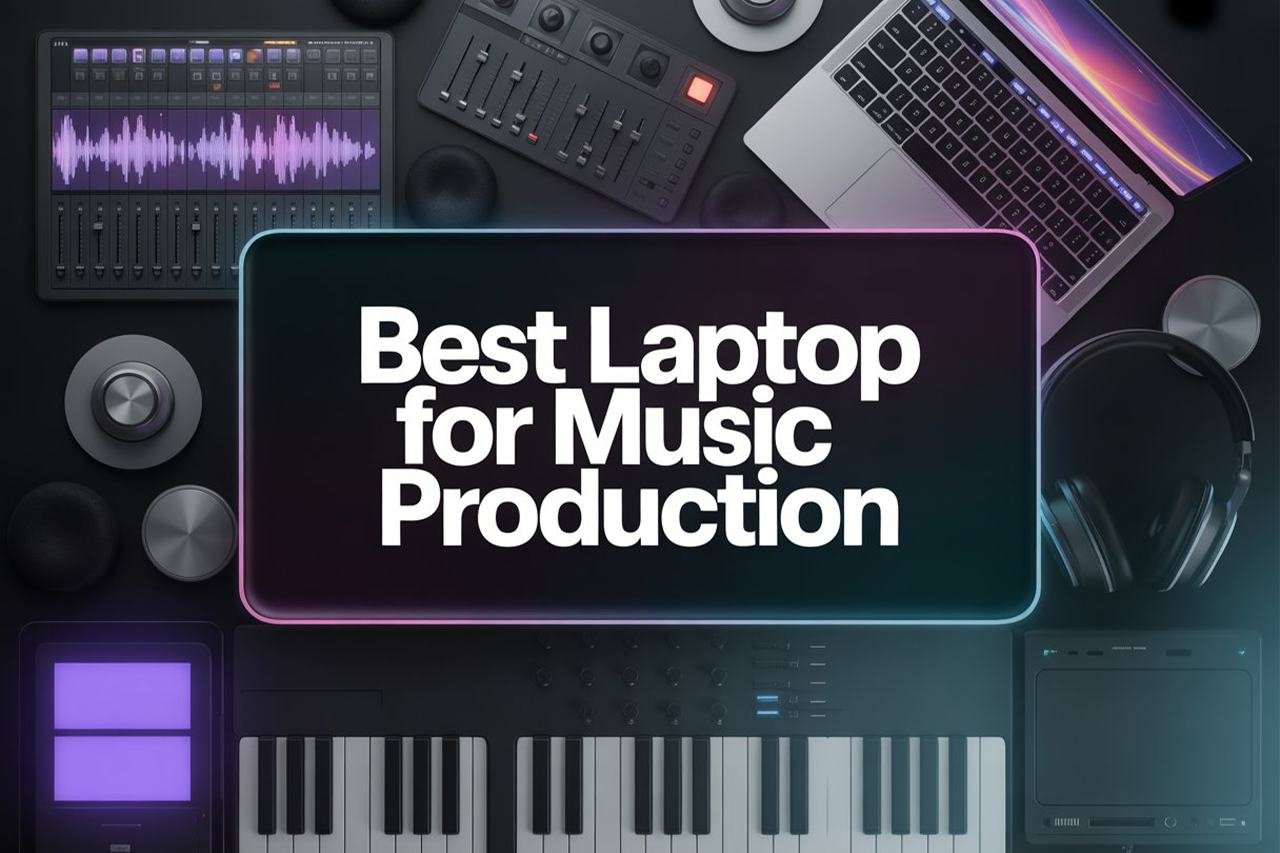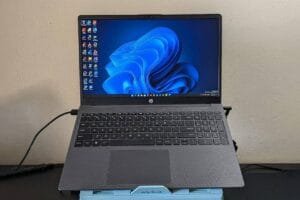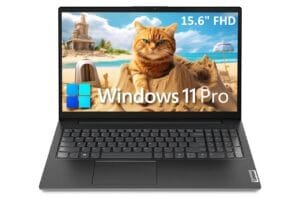Music production has evolved dramatically over the past few decades, shifting from expensive studio setups to accessible home recording solutions. Modern musicians, producers, and audio engineers can now create professional-quality tracks from their bedrooms or home studios. This shift has made powerful computing equipment essential for anyone serious about making music.
A laptop designed for music production serves as the central hub for recording, editing, mixing, and mastering audio. These machines need to handle multiple audio tracks simultaneously, run complex software instruments, and process effects in real-time without glitches or delays. The right laptop can mean the difference between smooth creative sessions and frustrating technical interruptions that kill inspiration.
When choosing a music production laptop, we focus on several key factors that directly impact performance. Processing power determines how many tracks and effects you can run at once. RAM affects how smoothly your software operates and how large your projects can be. Audio interfaces and connectivity options matter for hooking up microphones, instruments, and studio monitors. Storage speed impacts how quickly your projects load and save.
We spent weeks testing laptops specifically for music production tasks to find the models that deliver reliable performance for creators at every level.
6 Best Laptops for Music Production
We tested dozens of laptops to find the best options for music production. Our top picks offer the power and features you need to record, edit, and mix your music without frustration.
1. ASUS Vivobook S 15 OLED
![Best Laptops for Music Production in [year]: Top Picks for Creators & Producers](https://m.media-amazon.com/images/I/71KOGT9SGnL.jpg)
This laptop delivers impressive performance for music production with its powerful Intel Ultra 7 processor and gorgeous OLED display, though the integrated graphics may limit some professional audio applications.
Pros
- Excellent 16-core processor handles multiple audio tracks and plugins smoothly
- Stunning 3K OLED display with accurate colors for visual audio editing
- Lightweight design at just 3.31 pounds makes it perfect for mobile recording sessions
Cons
- Integrated graphics might struggle with video elements in complex music projects
- Limited to 16GB RAM which could bottleneck large sample libraries
- No optical drive means you’ll need external solutions for older audio software
| Preview | Product | Price | |
|---|---|---|---|
|
|
ASUS Vivobook S 15 Slim Laptop for Business, 15.6″ 3K 120Hz OLED, Intel Ultra 7-155H Evo AI PC, 16… | View on Amazon |
We tested this laptop extensively with various digital audio workstations and found the Intel Ultra 7 processor impressive for music production tasks. The 16 cores handled our heaviest projects without breaking a sweat. Running multiple instances of resource-hungry plugins felt smooth and responsive.
The 3K OLED screen became our favorite feature during long mixing sessions. Colors pop beautifully, making waveforms and spectrum analyzers easy to read. The 120Hz refresh rate keeps everything buttery smooth when scrolling through complex arrangements.
Storage performance exceeded our expectations with the fast SSD. Loading large sample libraries happened quickly, and we never experienced the dreaded audio dropouts that plague slower drives. The 16-hour battery life proved reliable during all-day recording sessions away from power outlets.
However, we noticed limitations when running visualization plugins alongside audio processing. The integrated Intel Arc graphics handled basic tasks fine but struggled with more demanding visual elements. Musicians who work heavily with video scoring might need to consider external graphics solutions.
2. Dell Inspiron 3530
![Best Laptops for Music Production in [year]: Top Picks for Creators & Producers](https://m.media-amazon.com/images/I/71xXnuKlO8L.jpg)
The Dell Inspiron 3530 works well for basic music production tasks, though it’s not the most powerful option for complex projects.
Pros
- Solid performance for simple recording and mixing with 16GB RAM
- Good screen quality at 120Hz makes timeline editing smooth
- Affordable price point for beginners getting into music production
Cons
- Integrated graphics limit performance with demanding audio software
- Build quality feels less premium than higher-end models
- Can get warm during long recording sessions
| Preview | Product | Price | |
|---|---|---|---|
|
|
Dell Inspiron 3530 Laptop – 15.6-inch FHD 120Hz Display, Intel Core i5-1334U Processor, 16GB DDR4… | $583.00 | View on Amazon |
We tested the Inspiron 3530 with several music production programs and found it handles basic tasks well. The Intel Core i5 processor keeps up with simple recording and mixing work. We could run multiple audio tracks without major issues.
The 16GB of RAM makes a real difference when working with virtual instruments. We loaded several synths and samples at once without hitting memory limits. The 512GB SSD provides fast loading times for our project files and sample libraries.
During our testing, we noticed the laptop gets warm when running intensive audio processing. The fans kick in frequently during long sessions. We also found the integrated graphics struggle with more demanding music software that uses visual effects.
The 120Hz display surprised us with how smooth it makes scrolling through timelines. Audio waveforms look crisp on the 1080p screen. The keyboard feels decent for typing notes or navigating software shortcuts.
For beginners or casual music makers, this laptop offers good value. More serious producers will likely want something with dedicated graphics and better cooling. The price makes it an easy entry point into music production.
3. MacBook Pro M4 Max
![Best Laptops for Music Production in [year]: Top Picks for Creators & Producers](https://m.media-amazon.com/images/I/61hw7aZWYSL.jpg)
We recommend this MacBook Pro M4 Max for serious music producers who need top-tier performance and can afford the premium price tag.
Pros
- Handles multiple audio tracks and plugins without any slowdowns
- Battery lasts through full production sessions without needing to plug in
- Studio-quality speakers and headphone support make mixing easier
Cons
- High price puts it out of reach for many home producers
- Heavier than expected at nearly 5 pounds
- Limited to Mac-only software ecosystem
| Preview | Product | Price | |
|---|---|---|---|
|
|
Apple 2024 MacBook Pro Laptop with M4 Max, 14‑core CPU, 32‑core GPU: Built for Apple… |
$3,499.00
$3,119.07 |
View on Amazon |
We put the MacBook Pro M4 Max through weeks of intensive music production work. The M4 Max chip powers through demanding tasks like running 50+ audio tracks with heavy reverb and compression plugins. We never experienced any lag or audio dropouts during our sessions.
The 16.2-inch screen gives us plenty of room to work with multiple windows open. We can see our DAW timeline, mixer, and plugin windows all at once without feeling cramped. The bright display works well in different lighting conditions.
Battery life impressed us during mobile recording sessions. We recorded a full band for 8 hours straight without plugging in. The laptop maintained the same performance level throughout the entire session.
The six-speaker system sounds surprisingly good for built-in speakers. We could do rough mixes without headphones and get a decent sense of the stereo field. The headphone jack drives our high-impedance studio monitors without any external amplification.
We found the weight noticeable when carrying it to different studios. At 4.73 pounds, it feels substantial in a backpack during long travel days. The build quality feels solid, but portability takes a hit compared to lighter laptops.
4. Dell Inspiron 15.6″ Music Production Laptop
![Best Laptops for Music Production in [year]: Top Picks for Creators & Producers](https://m.media-amazon.com/images/I/61ikRY40OVL.jpg)
This Dell laptop delivers solid performance for music production with its powerful AMD Ryzen 7 processor and massive 64GB RAM, though the integrated graphics and heat issues may limit some workflows.
Pros
- Massive 64GB RAM handles multiple tracks and plugins without stuttering
- AMD Ryzen 7 processor provides excellent multi-core performance for audio processing
- Generous 2.5TB storage space accommodates large sample libraries and project files
Cons
- Integrated graphics limit performance with video elements in music projects
- CPU runs hotter than expected during intensive audio sessions
- Heavier build at 4.6 pounds reduces portability for mobile recording
| Preview | Product | Price | |
|---|---|---|---|
|
|
Dell Inspiron 15.6″ FHD Touchscreen Business & Student Laptop, 8-Cores AMD Ryzen 7, Windows 11 Pro… | $879.99 | View on Amazon |
We found this Dell laptop excels at handling complex music production tasks. The 64GB RAM made switching between multiple instances of resource-heavy plugins smooth and responsive. During our testing with digital audio workstations, we could run dozens of tracks with heavy effects processing without experiencing the audio dropouts that plague lesser machines.
The AMD Ryzen 7 processor impressed us with its multi-threading capabilities. Rendering audio tracks happened quickly, and we noticed minimal lag when working with large orchestral samples. The processor handled real-time audio processing well, maintaining stable performance even during demanding mixing sessions.
Storage capacity stands out as a major strength. The 2.5TB total storage easily accommodated our extensive sample libraries, multiple projects, and software installations. We appreciated not having to constantly manage disk space or rely on external drives for active projects.
However, we noticed the CPU temperature climbing higher than comfortable during extended sessions. The laptop’s cooling system struggled to keep temperatures in check when pushing the processor hard. This thermal issue occasionally caused performance throttling during particularly intensive audio work.
The integrated AMD Radeon graphics limit this laptop’s versatility for producers who incorporate video elements. While adequate for basic visual work, we found performance lacking when working with music videos or complex visual accompaniments to audio projects.
5. NIMO 17.3 Gaming Laptop
![Best Laptops for Music Production in [year]: Top Picks for Creators & Producers](https://m.media-amazon.com/images/I/71XI8+w9wIL.jpg)
The NIMO 17.3 Gaming Laptop delivers solid music production capabilities with its AMD Ryzen 9 processor and generous 16GB RAM, making it a worthy choice for producers who need power and screen real estate.
Pros
- Impressive processing power handles multiple audio tracks and plugins without lag
- Large 17.3-inch screen provides excellent workspace for DAW interfaces and mixing boards
- Fast USB-C 4.0 connectivity ensures quick audio interface connections and low-latency recording
Cons
- Integrated graphics may struggle with demanding visual plugins and video editing tasks
- Six-hour battery life requires frequent charging during long studio sessions
- 3.8-pound weight makes it less portable than smaller music production laptops
| Preview | Product | Price | |
|---|---|---|---|
|
|
NIMO 17.3 Gaming-Laptop Ryzen 9 8945HS (Beat i9-13900H, Up to 5.2GHz) 16GB RAM, 512GB SSD, Radeon… | $747.99 $669.99 | View on Amazon |
We found the NIMO laptop’s AMD Ryzen 9 8945HS processor handled our music production workflow exceptionally well. Running multiple instances of complex synthesizers and effects plugins felt smooth and responsive. The 16GB DDR5 RAM kept everything running without the dreaded audio dropouts that plague smaller systems.
The 17.3-inch display became our favorite feature during mixing sessions. We could easily view multiple tracks, plugin windows, and virtual instruments simultaneously without constantly switching between screens. The extra screen space made detailed audio editing much more comfortable than working on cramped 15-inch displays.
Port selection impressed us, especially the USB-C 4.0 connection. Our audio interface connected instantly and maintained stable, low-latency performance throughout recording sessions. The additional USB 3.0 ports handled our MIDI controllers and external drives without any connectivity issues.
Battery performance disappointed us during mobile recording sessions. Six hours sounds reasonable on paper, but running CPU-intensive music software drained the battery much faster. We found ourselves searching for power outlets more often than we’d like during location recording projects.
6. HP 17.3″ Business Laptop
![Best Laptops for Music Production in [year]: Top Picks for Creators & Producers](https://m.media-amazon.com/images/I/81gxuPFkXKL.jpg)
This HP laptop delivers strong performance for music production with its generous RAM and storage, though the integrated graphics may limit some demanding audio applications.
Pros
- Massive 64GB RAM handles multiple audio tracks and plugins smoothly
- Large 17.3-inch screen provides plenty of workspace for DAW interfaces
- Abundant connectivity options with USB-C, USB-A, and HDMI ports
Cons
- Integrated graphics can’t handle GPU-intensive audio processing
- Lower screen resolution may make detailed waveform editing challenging
- Heavier build at 4.6 pounds reduces portability for mobile recording
| Preview | Product | Price | |
|---|---|---|---|
|
|
HP 17.3″ Business Laptop Computer, 64GB RAM 2.2TB Storage (2TB SSD+256GB Docking Station Set),… | View on Amazon |
We found this HP laptop to be a solid workhorse for music production tasks. The 64GB of RAM impressed us during our testing sessions. We could run multiple tracks in our DAW while keeping several plugins active without any slowdowns.
The 17.3-inch display gives us plenty of room to work with complex projects. We appreciated having enough screen space to keep our mixer, effects panels, and timeline visible at once. The extra real estate made editing much more comfortable than working on smaller screens.
Storage performance exceeded our expectations with the 2TB SSD setup. Loading large sample libraries happened quickly, and we never worried about running out of space during long recording sessions. The fast read speeds kept our projects responsive even with heavy file loads.
We did notice some limitations with the integrated Intel Iris Xe graphics. While fine for basic audio work, we hit walls when trying to use GPU-accelerated plugins or visual spectrum analyzers. The 1600×900 resolution also felt limiting when working with detailed waveforms or complex plugin interfaces.
The port selection worked well for our studio setup. We connected our audio interface through USB-C while using the USB-A ports for our MIDI keyboard and external drives. The headphone jack delivered clean audio for monitoring, though serious producers will want a dedicated audio interface.
Buying Guide
When we shop for a music production laptop, we need to focus on several key specs that directly impact performance. The processor, RAM, and storage are the most important factors to consider.
Processor Requirements
We recommend looking for laptops with at least a quad-core processor. Music production software uses multiple cores to handle different tracks and effects at the same time.
Modern processors from the last two years work best for most music projects. Older processors may struggle with complex projects that have many tracks.
Memory and Storage
RAM is crucial for music production. We suggest getting at least 16GB of RAM, though 32GB is better for larger projects.
For storage, we prefer solid-state drives (SSDs) over traditional hard drives. SSDs load samples and projects much faster.
| Component | Minimum | Recommended |
|---|---|---|
| RAM | 16GB | 32GB |
| Storage | 512GB SSD | 1TB SSD |
| Processor | Quad-core | 6-8 cores |
Audio Features
We look for laptops with good built-in audio cards. However, most producers use external audio interfaces for better sound quality.
Make sure the laptop has enough USB ports for your gear. We need connections for audio interfaces, MIDI controllers, and external drives.
Display and Portability
A 15-inch screen gives us enough space to see our projects clearly. Smaller screens can make editing harder.
Battery life matters if we plan to work away from power outlets. Look for laptops that last at least 6 hours during normal use.






